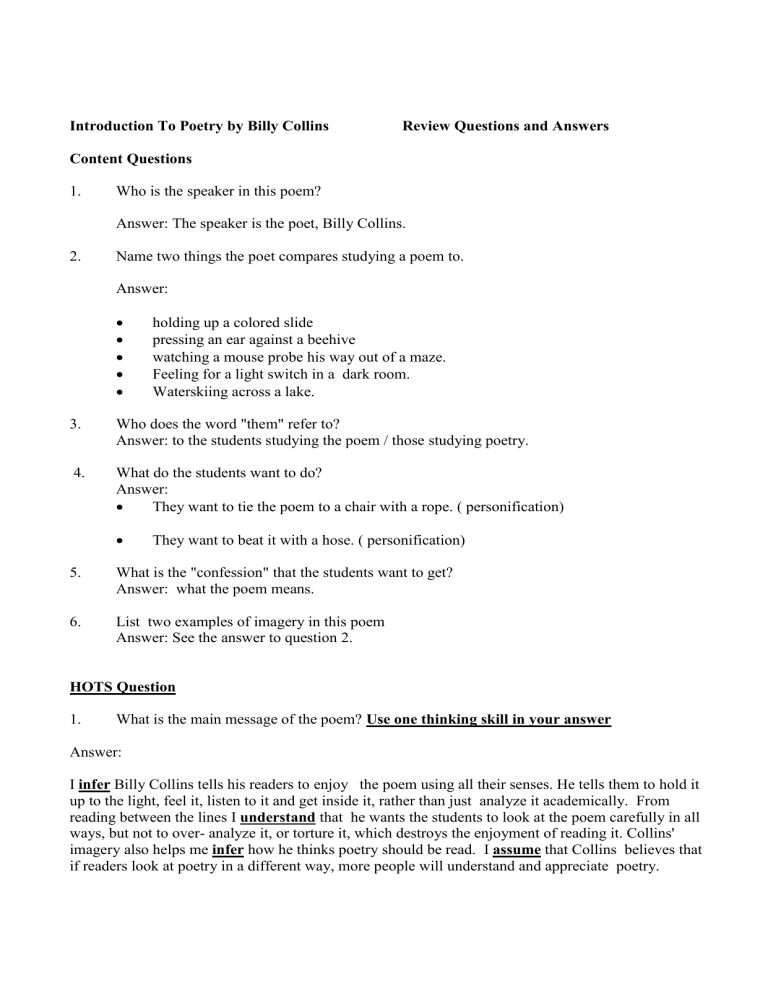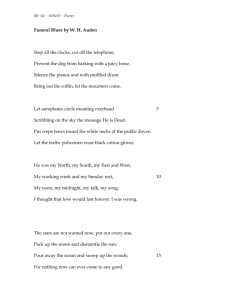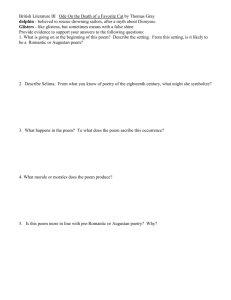Introduction to Poetry by Billy Collins Worksheet

Introduction To Poetry by Billy Collins Review Questions and Answers
Content Questions
1. Who is the speaker in this poem?
Answer: The speaker is the poet, Billy Collins.
2. Name two things the poet compares studying a poem to.
Answer:
holding up a colored slide
pressing an ear against a beehive
watching a mouse probe his way out of a maze.
Feeling for a light switch in a dark room.
Waterskiing across a lake.
3. Who does the word "them" refer to?
Answer: to the students studying the poem / those studying poetry.
4. What do the students want to do?
Answer:
They want to tie the poem to a chair with a rope. ( personification)
They want to beat it with a hose. ( personification)
5. What is the "confession" that the students want to get?
Answer: what the poem means.
6. List two examples of imagery in this poem
Answer: See the answer to question 2.
HOTS Question
1. What is the main message of the poem? Use one thinking skill in your answer
Answer:
I infer Billy Collins tells his readers to enjoy the poem using all their senses. He tells them to hold it up to the light, feel it, listen to it and get inside it, rather than just analyze it academically. From reading between the lines I understand that he wants the students to look at the poem carefully in all ways, but not to over- analyze it, or torture it, which destroys the enjoyment of reading it. Collins' imagery also helps me infer how he thinks poetry should be read. I assume that Collins believes that if readers look at poetry in a different way, more people will understand and appreciate poetry.
NOTE : You can answer the question also using Distinguishing Different Perspectives, Explaining
Cause and Effect or Uncovering Motives.
2. How does Collins want students to explore a poem?
Answer:
Holding up a colored slide: He wants students to hold a poem up to the light, just as you would a color slide. This way you can always see something a bit different, as if you look at a slide, which can be shifted to get a new angle.
Pressing an ear against a beehive. The speaker wants students to " listen" to the poem and learn about it that way. He compares listening to a poem to listening to a beehive.
Watching a mouse probe its way out of a maze. The speaker urges students to analyze a poem in many different ways, He compares studying a poem to a mouse that wants to get out of a maze and has to try all ways to do so.
Feeling for a light switch in the dark. The speaker wants the students to analyze a poem in the same way that that someone gropes for a light switch in a dark room. Someone looking for a light switch in the dark has to use his other senses such as touch, to find the switch.
Waterskiing across a lake. The speaker wants the students to analyze a poem in a fun way. Here he also says a wave should be given to the author, perhaps asking the reader to be respectful while analyzing the poem.
3. How does the speaker feel about the analysis of poetry?
He believes that it needs to be less academic and more creative. He thinks analysis can ruin the love for literature and can isolate many potential readers.
4. What is personified in the poem?
Answer :
The poem itself is personified because it is tied to a chair and beaten and tortured like a prisoner or an enemy. Collins uses personification to create a strong picture of what we shouldn't do.
6. Why do you think the poem is called introduction to poetry?
Billy Collins wants to reintroduce the study of poetry. He wants to introduce students to a new and creative way of reading poetry.
Bridging Question.
Billy Collins is an American poet. Named Poet Laureate (ימואל ררושמ( of the United States in
2001, Collins believes poetry should be enjoyed by everyone. He started a program called poetry
180. In an interview , Collins explained that the poems should also be read out loud outside the classroom. "The idea would be to have high school students hear a poem every day, so that the poem will be a feature of daily life and not something that is just taught."
How does this information add to your understanding of the poem?
Answer
There is a clear connection between the information and the poem.
From the poem I understand how important poetry is for Billy Collins. He believes that reading a poem or listening to it should be an enjoyable experience. He says that everybody can should be able to enjoy poetry without analysis and formal study, which can sometimes ruin the poem. This is exactly what the poem is about . He calls on people to use their senses when studying poetry, using images like looking for a light switch in the dark , or holding it against the light to examine it carefully, or water-ski across the poem's surface.
To sum up, the information helps me understand better the message of the poem.







